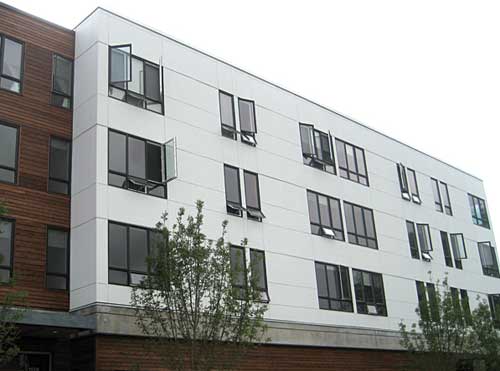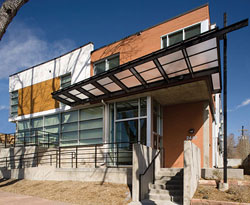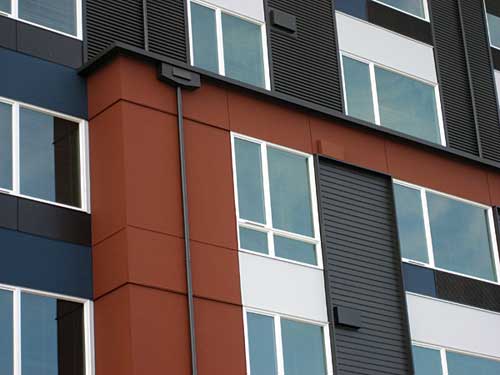Intrinsic Materials: Modernism, Sustainability and Fiber Cement Panels
Fiber cement panels are a product of choice for architects designing towards a low carbon footprint. As building design scientist Joseph Lstiburek, B.A. Sc., MEng., PhD., P.Eng, attests, "The single most important factor in green architecture is durability. If you want something to be green it has to last a long time. It has to handle water, heat and UV radiation. Fiber cement handles all three exceptionally well." Durability means longevity and the ability to weather well in both wet and hot weather, as well as resist ultraviolet damage.
New fiber cement panel solutions with expressed seams can be both an important design decision as well as a good environmental choice for a wall cladding. They are made of a material that is both low in toxicity as well as extracted regionally. They are durable, flexible and long lasting. They can be manufactured and engineered specifically to meet the rigors of any climate zone.
 |
Fiber cement panels were used to express variation in this Portland, Oregon façade. Photo courtesy of James Hardie |
Â
Until recently, designers have been limited to using this product by the manufacturer's production of only surfaces that mimic wood and wood siding products. Professionals have also chosen metal panels that were manufactured to a standardized "grid" limiting the aesthetic vocabulary or requiring additional costs to express unique patterns and rhythms. Another material alternative has been the use of stucco infill with wooden or metal reveals. Besides using more material, stucco, as well as its modern synthetic substitution, weathers poorly, can leave gypsum or plastic residue in the soil and requires more clean-up after installation.
In a speech given by architect Andres Duany, FAIA at the University of Michigan in the late 1990s, this traditionalist, lamented the fact that manufacturers did not provide the designer with intrinsic materials, those that celebrated their essence. He pointed out that designers' choices were often limited to mass produced materials that were replications of older products. Fiber cement panel solutions with expressed joints may be one of the break-through products that will answer his quest for an intrinsic material in a contemporary building product.
DESIGN: A THEORETICAL BASIS
Modernism and the quest for new materials
In a 1920s Bauhaus article translated as "Must Painting be Considered Inferior to Architecture?," artist Piet Mondrian discusses the "new" aesthetics of art and architecture. As a painter, Mondrian investigated the effects of a "bounded plane" that created a surface to engage the viewer in a conversation and reflection on form and space. He writes about art and architecture, "Pure design is the…equivalent representation of things that are permanent and transitory. It is design with straight lines. As a result of the new aesthetics, painting and architecture are consistently executing compositions of counter balancing and contrasting straight lines, thus changing the duality of the unchangeable, right angle into multiplicity. As preparation for a universal realization of beauty, a new art and a new aesthetic are neeeded."2 Architects today continue to explore how to express the straight lines, the art of architecture in a sustainable, modern and urban expression.
The Juan Diego Apartments - Denver, CO |
|
Architect Yong Cho, principal of studio completiva, in Denver, Colorado, says, "We use fiber cement cladding primarily because it is a cost-effective, durable product that allows us flexibility in designing the building skin. Using the smooth face of fiber cement panels and expressing the joints between panels gives us the urban aesthetic we prefer. Fiber cement panel also allows the flexibility of using rain screen systems we believe are environmentally responsible." The Juan Diego Apartments were designed by Yong Cho, a project he dedicated to his mother, Sung Ja Cho. This 26,970-square foot three-story building was developed by the Del Norte Neighborhood Development Corporation to provide needed housing for the homeless who courageously are battling AIDS. The building consists of a lobby, community room and a twenty-four space parking garage on the first level with seventeen apartments above on the second and third levels. The building is constructed mainly with load-bearing framing, concrete and concrete masonry units on the first floor. The project was designed to meet a low budget without sacrificing environmental performance. |

The Juan Diego Apartments demonstrate how fiber cement panels with expressed joints can be used to express an urban, contemporary aesthetic. Photo courtesy of studio completiva |
Â
Mid-twentieth century modernist architects, such as Saarinen and Mies Van der Rohe, explored the concept of intrinsic expression, buildings that celebrated their materials and connections. Using simple, planar, pure forms, modernists translated Mondrian's lines and planes into panels and reveals. The composition of the façade expressed the structural and behavioral program of the building and elevated the skin of a building into a work of art. Mies emphasized that design was not "decorating." Less is more, but also related to a complex system of design relationships.
 |
The designer chose a limited palette of secondary hues. Rust, navy, cool gray and white provide contrast in the expression of this façade. Photo courtesy of James Hardie |
Â
As 21st century architects explore these concepts, as well as integrating their designs with environmental mandates, they challenged manufacturers to provide the materials needed for continued development of the façade and environmental wall systems. Influenced by these modern and contemporary designers, the fiber cement industry has stepped up to meet the needs of modernist, urban and contemporary expressions. A cement fiber panel system allows the designer to create any horizontal or vertical rhythm or pattern that expresses their individual design aesthetic. Fiber cement panels with expressed grids are not manufactured to a standard application size although they are delivered to the site in standard modules that can be cut to size. The panels are both mass produced, yet able to be individualized by design and construction. Field installations provide the flexibility of installing the grids and placing the panels to express that "bounded plane" that Mondrian celebrated in the 1920s as a new aesthetic.









